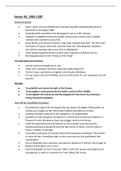Summary
Complete Summary of Henry VII's Reign,
A thorough and cohesive summary of all aspects of Henry VII's reign. His response to threats such as rebellions are also evaluated in detail. Particular attention is paid to the central themes that form the basis of exam questions e.g. achievement/failure to achieve aims in government, extent to wh...
[Show more]




